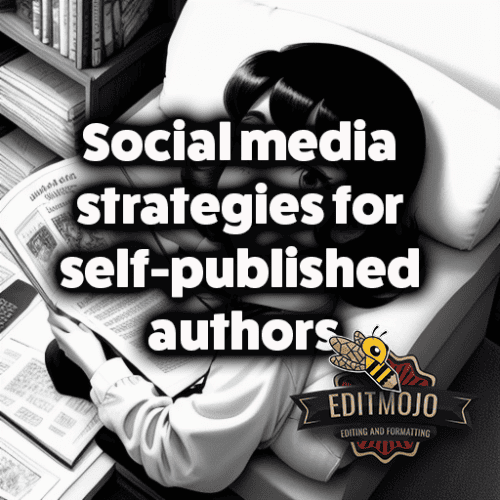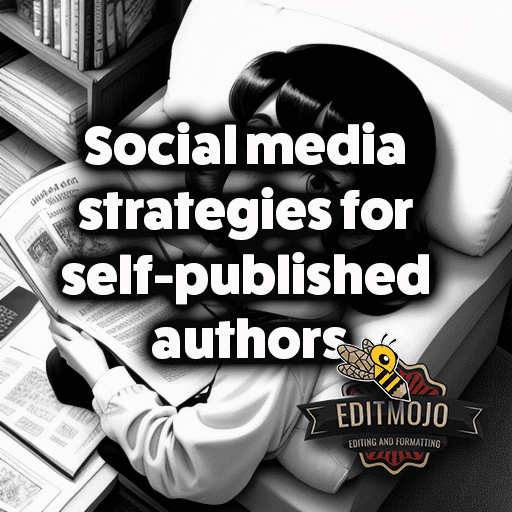Social media strategies for self-published authors
Social media strategies for self-published authors. In the grand tapestry of the digital age, social media has woven itself into the very fabric of our daily lives. For self-published authors, it represents an invaluable resource. A tool to level the playing field, transforming the solitary art of writing into a shared journey with readers worldwide. In this comprehensive guide, we delve into unique and exciting strategies that will take your social media presence to the next level.
Key Takeaway Table: Social Media Strategies for Self-Published Authors
| Key Takeaways |
|---|
| 1. Choose the social media platforms that best align with your target audience and content style. |
| 2. Create a robust social media profile with an appealing profile picture, cover photos, and a compelling biography. |
| 3. Experiment with various types of content, including book excerpts, behind-the-scenes glimpses, cover reveals, and author interviews. |
| 4. Develop a consistent visual theme and use tools like Canva or Adobe Spark to create eye-catching visuals. |
| 5. Engage with your audience through comments, messages, collaborations, and hosting live events to build a strong online community. |
| 6. Schedule your posts using tools like Buffer or Hootsuite to maintain consistency and reach your audience at optimal times. |
| 7. Consider leveraging social media ads to expand your reach and target specific audiences. Track ad performance for future optimization. |
| 8. Learn from successful self-published authors who have effectively utilized social media. |
| 9. Stay informed about the latest social media trends to keep your content fresh and engaging. |
| 10. Explore resources and communities dedicated to self-published authors for additional support and guidance. |
II. Understanding the Landscape of Social Media
In the vast digital jungle, different social media platforms offer varied benefits. Let’s explore the leading contenders.
A. Examination of the Leading Social Media Platforms
- Facebook: With over 2.8 billion users as of 2021, Facebook is a digital colossus. It’s a fantastic platform for creating an author page and connecting with reader groups.
- Twitter: The brevity of tweets fosters a certain poetry, making Twitter a favourite among authors. Twitter chats like #WritingCommunity can provide immense value and camaraderie.
- Instagram: This highly visual platform thrives on aesthetic appeal. For the creative author, Instagram can showcase book covers, quotes, and glimpses into the writing process.
- LinkedIn: This professional network is ideal for non-fiction authors to establish credibility in their field.
- YouTube: The world’s second-largest search engine, YouTube offers a medium for authors to share book trailers, author interviews, and more.
- Pinterest: An underappreciated gem, Pinterest can be used to share inspirational boards related to your books or writing process.
- TikTok: The new kid on the block, TikTok has surged in popularity. Its viral, short-form video content holds potential for authors to reach a younger demographic.
- Clubhouse: The audio-based app is perfect for hosting book discussions or author interviews.
B. Identifying the Best Platforms for Authors
In the wise words of Sun Tzu, “Know thyself and know thy enemy.” While the social media world is not your enemy, the analogy holds. The ‘best’ platform will depend on your target readership, your comfort with the platform, and the kind of content you can consistently create.

III. Building a Robust Social Media Profile
Imagine your social media profile as your book’s front cover. It should be compelling and intriguing, leaving the viewer wanting more.
A. Choosing the Right Profile Picture and Cover Photos
Your profile picture is your first impression. A professional, high-quality author headshot can work wonders. Your cover photo should complement this, perhaps showcasing your books, a personal mantra, or a beautiful writing-related scene.
B. Crafting a Compelling Biography
Your bio should succinctly convey who you are as an author and what readers can expect from your books. For inspiration, check out Neil Gaiman’s Twitter bio. He elegantly encapsulates his quirky personality and his work, all while maintaining intrigue.
C. Adding Website and Contact Information
Don’t forget to include a link to your website and a way to contact you. Social media platforms are just the tip of the iceberg; you want people to dive deeper into your world.
D. Maintaining a Consistent Visual Theme
Just as your writing has a unique voice, your social media should have a unique visual style. This consistency fosters recognizability and strengthens your personal brand.

IV. Content Creation: From Conception to Publication
Your social media content is like your book’s plot—it needs to captivate your audience and keep them coming back for more.
A. Understanding What Content Works for Authors
- Book excerpts: Tease potential readers with snippets from your book. Kindlepreneur’s guide to writing compelling blurbs can help you craft these.
- Behind the scenes of the writing process: Let your audience peek behind the curtain. This might be your writing space, your manuscript in progress, or your beloved cat who always keeps you company.
- Cover reveals: A grand unveiling of your book cover can create buzz and anticipation.
- Author interviews: Show the person behind the pen. Answer reader questions, share writing tips, or discuss your journey as an author.
B. Creating a Unique Visual Style
Use tools like Canva or Adobe Spark to create stunning images, infographics, or short videos consistent with your visual theme. As author Mark Twain said, “The difference between the right word and the almost right word is the difference between lightning and a lightning bug.” The same goes for your visual content.
C. Writing Engaging Captions and Using Effective Hashtags
Captions should complement your visuals. They could tell a story, ask a question, or include a call-to-action. Pair this with effective hashtags to increase visibility.
D. Utilizing Stories, Reels, IGTV, Facebook Live, etc.
Different content formats can cater to different segments of your audience. Instagram Stories and Reels, IGTV, Facebook Live, Twitter Fleets, etc., offer fresh, engaging ways to connect with your audience.
V. The Art of Social Media Engagement
In the words of author Johann Wolfgang von Goethe, “One ought, every day at least, to hear a little song, read a good poem, see a fine picture, and, if it were possible, to speak a few reasonable words.” As an author, your words can inspire your social media community daily.
A. Building and Fostering Online Communities
- Joining relevant author and reader groups: Groups are treasure troves of like-minded individuals. Participating can increase your visibility and credibility.
- Participating in relevant hashtag trends and challenges: Hashtag trends, like #ThrowbackThursday or #FridayReads, can boost your post’s reach.
B. Responding to Comments and Messages
Interacting with your followers strengthens your connection with them. A simple reply can transform a casual follower into a dedicated fan.

C. Collaborating with Other Authors and Influencers
Collaborations can mutually increase reach and provide fresh content. Consider co-hosting a webinar, doing a joint book giveaway, or conducting an Instagram Live chat.
D. Hosting Live Q&A Sessions, Giveaways, Contests
Such events foster engagement and excitement. They make your followers feel valued and involved in your journey.
VI. Social Media Scheduling and Consistency
Consistency in posting can be as critical as consistency in your writing routine. It keeps you on your followers’ radar and shows your commitment.
A. The Importance of Regular Posting
Regular posting fosters a sense of predictability and trust with your audience. It’s like your favorite TV show; you expect a new episode every week.
B. Understanding Peak Times
Different platforms and different audience demographics have unique peak times. Tools like Sprout Social can provide insight into the best times to post.
C. Using Scheduling Tools
Scheduling tools, like Buffer or Hootsuite, can save time and ensure your posts go live at optimal times.
D. Creating a Content Calendar
A content calendar helps organize your social media strategy, ensuring a balanced mix of content.
VII. Leveraging Social Media Ads for Self-Published Authors
Social media ads can provide that extra push to increase book sales and reach a broader audience.
A. Overview of Social Media Advertising
Paid promotions can increase your reach beyond your existing followers. Each platform offers different ad formats to suit your goals.
B. Targeting the Right Audience
Ads enable precise targeting. You can reach potential readers based on their age, interests, location, and more.
C. Creating Engaging Ads
Your ads should capture attention and provoke action. Compelling visuals, combined with a powerful call-to-action, can significantly improve performance.
D. Measuring Ad Performance
Most social media platforms provide analytics to track your ad’s performance. This data can inform future ad strategies.
VIII. Case Studies: Successful Self-Published Authors on Social Media
Successful self-published authors, like E.L. James, author of Fifty Shades of Grey, and Andy Weir, author of The Martian, effectively use social media to connect with their readers and promote their work. Their strategies might inspire your own approach.
IX. Staying Up-to-Date with Social Media Trends
Staying current with social media trends can give you an edge and keep your content fresh and relevant.
X. Conclusion (Social media strategies for self-published authors)
Social media offers self-published authors incredible opportunities. By understanding the landscape, crafting compelling profiles, creating engaging content, building community, staying consistent, leveraging ads, and staying informed, you can elevate your authorial presence and success.
XI. Bonus: Resources for Self-Published Authors
Finally, a quick list of resources: Kindlepreneur, Reedsy, Self Publishing School, ALLi, and Writer’s Digest provide wonderful support for self-published authors.
Remember, each social media journey is unique. Yours will be too. Embrace the experiment, and enjoy the journey. After all, as an author, you’re adept at crafting narratives. Now, it’s time to tell your own.
Top Five Questions and Answers: Social Media Strategies for Self-Published Authors
| Questions | Answers |
|---|---|
| 1. Which social media platforms are most effective for self-published authors? | The choice of platforms depends on your target audience and content style. Facebook, Twitter, Instagram, YouTube, and LinkedIn are commonly used by authors. Assess which platforms align with your goals and audience demographics. |
| 2. How can I create engaging content for social media? | Engaging content can include book excerpts, behind-the-scenes glimpses, cover reveals, and author interviews. Use visually appealing images, videos, and infographics to capture attention. Craft compelling captions and utilize effective hashtags to increase discoverability. |
| 3. How can I build a strong online community as a self-published author? | Join relevant author and reader groups on social media platforms. Participate in hashtag trends and challenges. Respond to comments and messages from your audience. Collaborate with other authors and influencers. Host live Q&A sessions, giveaways, and contests to foster engagement. |
| 4. Is it necessary to schedule social media posts? | Scheduling posts is essential for maintaining consistency and reaching your audience at optimal times. Use scheduling tools like Buffer or Hootsuite to plan and automate your content. A content calendar helps you organize your posting strategy effectively. |
| 5. Should I consider using social media ads as a self-published author? | Social media ads can be a valuable tool to expand your reach and target specific audiences. Define your goals, choose the platforms that offer ad capabilities, and create engaging ad content. Monitor and measure ad performance to optimize your campaigns for better results. |
